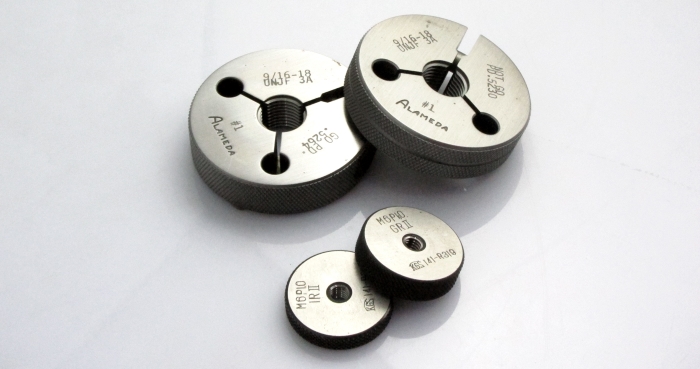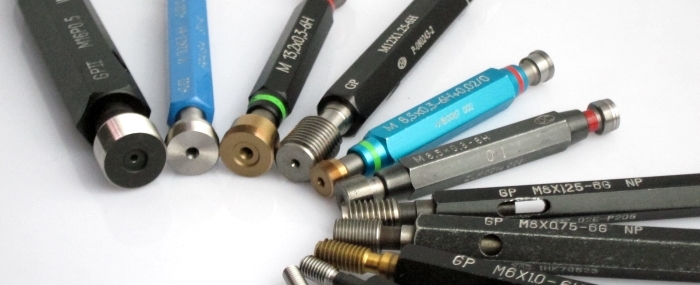Thread Gauge for instant measurement2016-07-18
So far, most of APPORO’s CNC machining services cases include inner or external thread machining. The reason for CNC machining parts featured with thread is mainly for assembly. However, there are a variety of thread specs for various industrial application purposes. For example, ISO Metric Standard, Unified Thread Standard, National pipe thread, British standard pipe thread, Acme thread, etc. Therefore, there are various methods to inspect the quality of machined thread, such as using three wire method, and thread gauges. For fast and instant measurement, we prefer thread gauges. Generally, thread gauges can be divided into two types. One is ring gauges for inspecting external thread, and the other is plug gauges for inspecting inner threaded hole. Both types are supplied with Go and No Go gauges to check if the thread does not conform to its allowed tolerance.
Why do we use thread gauge?
Thread gauges can ensure interchangeability of precision machined parts between different manufacturing procedures in CNC precision machined components industry.
After drilling a threaded hole or machining an external thread on precision CNC part, we usually use gauges to instantly check if we manufacture the thread properly and precisely. The photo below shows the two gauges we mainly used at APPORO-CNC:
Plug thread gauge
A plug gauge is for inner thread measurement. As for ISO metric standard, we generally use both 6H and 6G grade for thread inspection. Each plug gauge is with two threaded ends, Go and No Go. This is what we can learn from using a plug gauge:
1.) Go doesn't go: inner threaded hole too small or wrong pitch Do take notice of this situation! Inner thread being too small or with wrong pitch can result in assembly problem or field failures.
2.) No Go but go: inner threaded hole too big.
You can take Use As It(UAI) action for this situation if the inner thread still work withs mating part without functional issue. But make sure to improve current process to eliminate this issue for long term production.

Ring thread gauge
Ring gauge is for external thread measurement purpose. We generally use both 6h and 6g grade for ISO thread inspection. Each set of ring gauge is with two components, Go and No Go. Similar to using a plug gauge, this is what we can learn from using a plug gauge:
1.) Go doesn't go: external thread too big or wrong pitch Do take notice of this situation! Inner thread being too big or with wrong pitch can result in assembly problem or field failures.
2.) No Go but go: external thread too small.
You can take Use As It(UAI) action for this situation if the inner thread still work with mating part without functional issue. Make sure to current process to eliminate this issue for long term production.
How a thread gauge works?
In general, we use the thread gauge to inspect the thread of CNC fabricated workpiece. A thread gauge does not reflect on an actual size or measurement from inspection. instead, it only indicates a status which is either acceptable or unacceptable. When a CNC precision manufacturing part passes the thread gauge testing, it means the thread is within the tolerance, vise versa.
If needed, we also accept customized gauges order for both plug gauge and ring gauge. Contact us to get your own thread gauges, and keep your production lines running smooth without incorrect thread fitting. Let us know about your inquiry including thread spec details for prompt machining service. You can also visit Wikipedia for more understanding about screw thread.
--
Reader's Letter:
Hi Steven,
I am a mechanical engineering student. I was going through some case studies on functional gauge and i came across the article on case study of Thread gauge in your website. I was curious to know how much money can be saved using a thread gauge on an average and some of the companies that use these thread gauge to ensure tolerance limit of the product. So could you please give me some insight on these information?.
Thanks and Regards.
APPORO's Reply:
Hi Anirudhan,
Thread gauge is kind of aid for quality inspection, but not for saving production cost from manufacturing. However, to use standard thread gauge for inspection is a must for being a responsible supplier and also the best way to make sure steady thread quality.
For your reference, customized thread gauges which are not commonly used might be at least 3 times to the price of general gauges. The bigger the size of the thread, the more expensive the thread gauge.
Best regards,

